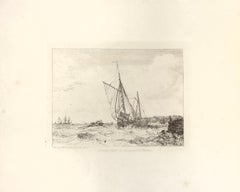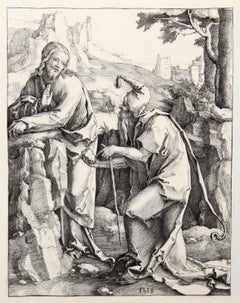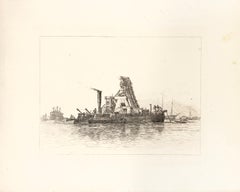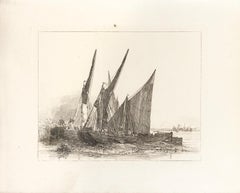19th Century More Prints
to
104
375
59
40
7
9
Overall Width
to
Overall Height
to
10
9
2
1
1
1
1
1
35
18
15
7
7
242
490
4,405
2,989
29
54
73
121
231
343
770
1,056
555
373
177
298
191
1
8
6
4
3
3
2
2
2
2
1
1
1
1
1
1
1
1
1
1
1
226
174
75
17
11
56
124
285
30
Period: 19th Century
36: Gadus merlangus, Whiting
Located in Columbia, MO
Edward Donovan (1768–1837) was an Anglo Irish writer, natural history illustrator and amateur zoologist. Born in Cork, Ireland, Donovan was an avid collector of natural history speci...
Category
19th Century More Prints
Materials
Color, Etching
05: Cowes Boat
Located in Columbia, MO
Edward William Cooke was born in Pentonville. His father, George Cooke, and uncle William Bernard Cooke were also well-known line engravers. Growing up in an environment of artists,...
Category
19th Century More Prints
Materials
Etching
Jesus Christ tente par le Demon, Heliogravure by Lucas van Leyden
By Lucas van Leyden
Located in Long Island City, NY
Artist: Lucas van Leyden, After by Amand Durand, Dutch (1494 - 1533) - Jesus Christ tente par le Demon, Year: 1873, Medium: Heliogravure, Size: 7.5 x 5.5 in. (19.05 x 13.97 cm), Pr...
Category
19th Century More Prints
Materials
Etching
57: Mud Dredger
Located in Columbia, MO
Edward William Cooke was born in Pentonville. His father, George Cooke, and uncle William Bernard Cooke were also well-known line engravers. Growing up in an environment of artists,...
Category
Naturalistic 19th Century More Prints
Materials
Etching
47: Barges
Located in Columbia, MO
Edward William Cooke was born in Pentonville. His father, George Cooke, and uncle William Bernard Cooke were also well-known line engravers. Growing up in an environment of artists,...
Category
Naturalistic 19th Century More Prints
Materials
Etching
53: Fishing Smack, Schooner, Sloop-rigged Barge
Located in Columbia, MO
Edward William Cooke was born in Pentonville. His father, George Cooke, and uncle William Bernard Cooke were also well-known line engravers. Growing up in an environment of artists,...
Category
Naturalistic 19th Century More Prints
Materials
Etching
45: Hog Boat on the Sands at Brighton
Located in Columbia, MO
Edward William Cooke was born in Pentonville. His father, George Cooke, and uncle William Bernard Cooke were also well-known line engravers. Growing up in an environment of artists,...
Category
Naturalistic 19th Century More Prints
Materials
Etching
Ex Libris Jarmay Zoltan - Woodcut - Early 20th Century
Located in Roma, IT
Ex Libris Jarmay Zoltan is an original Contemporary Artwork realized in the 19th Century.
Original Ex Libris.
Original B/W woodcut print on ivory-colored paper. Titled on the centr...
Category
Modern 19th Century More Prints
Materials
Woodcut
Abraham et les Trois Anges, Heliogravure by Lucas van Leyden
By Lucas van Leyden
Located in Long Island City, NY
Artist: Lucas van Leyden, After by Amand Durand, Dutch (1494 - 1533) - Abraham et les Trois Anges, Year: 1873, Medium: Heliogravure, Size: 7.5 x 5.75 in. (19.05 x 14.61 cm), Printe...
Category
19th Century More Prints
Materials
Etching
John Thomson (1777-1840) - 1830 Map Engraving, The Rivers of the World
By John Thomson
Located in Corsham, GB
A fine engraved chart table showing the lengths of the principal rivers across the world, from the second edition of John Thomson's 'New General Atlas' published in 1830. On paper.
Category
19th Century More Prints
Materials
Engraving
$349 Sale Price
20% Off
Marie Madeleine se Livrant aux Plaisirs du Monde by Lucas van Leyden
By Lucas van Leyden
Located in Long Island City, NY
Artist: Lucas van Leyden, After by Amand Durand, Dutch (1494 - 1533) - Marie Madeleine se Livrant aux Plaisirs du Monde, Year: 1873, Medium: Heliogravure, Size: 12 x 16 in. (30.48 ...
Category
19th Century More Prints
Materials
Etching
Jesus Christ apparaissant a la Madeleine sous la fourme d'un Jardiner
By Lucas van Leyden
Located in Long Island City, NY
Artist: Lucas van Leyden, After by Amand Durand, Dutch (1494 - 1533) - Jesus Christ apparaissant a la Madeleine sous la fourme d'un Jardiner, Year: 1873, Medium: Heliogravure on Laid...
Category
19th Century More Prints
Materials
Etching
Ancient Map of Africa - Etching - 19th century
Located in Roma, IT
This Map of Africa is an etching realized in the 19th century.
The state of preservation of the artwork is good. At the top of the paper, the inscription “Longitudine del Meridiano ...
Category
19th Century More Prints
Materials
Etching
Assembly - Lithography on Paper by G. Engelmann - 1825
By G. Engelmann
Located in Roma, IT
Assembly is an original lithography on paper, realized by G. Engelmann in 1825, the artwork is signed and dated on plate.
Sheet dimensions: 27 x 27 cm.
Includes a white passepartou...
Category
19th Century More Prints
Materials
Lithograph
La Tendresse Champetre, Heliogravure by Adriaen van Ostade
Located in Long Island City, NY
Artist: Adriaen van Ostade, After by Amand Durand, Dutch (1610 - 1685) - La Tendresse Champetre, Medium: Heliogravure, Size: 7.5 x 5.5 in. (19.05 x 13.97 cm), Printer: Amand Durand...
Category
19th Century More Prints
Materials
Etching
Bird's Eye View of Glascow 1888 original wood engraving from The Graphic
Located in Paonia, CO
Bird’s Eye View of Glascow original 1888 wood engraving is from The Graphic by H.W. Brewer who was well known for his aerial views of topographical panoramas. He was also the fa...
Category
Realist 19th Century More Prints
Materials
Woodcut
10: Thames Barge
Located in Columbia, MO
Edward William Cooke was born in Pentonville. His father, George Cooke, and uncle William Bernard Cooke were also well-known line engravers. Growing up in an environment of artists,...
Category
Naturalistic 19th Century More Prints
Materials
Etching
Le Retour de l'enfant Prodigue, Old Masters Heliogravure by Lucas van Leyden
By Lucas van Leyden
Located in Long Island City, NY
Artist: Lucas van Leyden, After by Amand Durand, Dutch (1494 - 1533) - Le Retour de l'enfant Prodigue, Year: 1873, Medium: Heliogravure, Size: 8 x 10 in. (20.32 x 25.4 cm), Printer...
Category
19th Century More Prints
Materials
Etching
49: Dutch Galliots
Located in Columbia, MO
Edward William Cooke was born in Pentonville. His father, George Cooke, and uncle William Bernard Cooke were also well-known line engravers. Growing up in an environment of artists,...
Category
Naturalistic 19th Century More Prints
Materials
Etching
63: Fishing Boat
Located in Columbia, MO
Edward William Cooke was born in Pentonville. His father, George Cooke, and uncle William Bernard Cooke were also well-known line engravers. Growing up in an environment of artists,...
Category
Naturalistic 19th Century More Prints
Materials
Etching
Planetary System - From Nuovo Atlante di Geografia Universale - 1820
Located in Roma, IT
Planetary System - From Nuovo atlante di geografia universale is an original print realized in 1820 by Luigi Rossi.
Original black and white etching. Prin...
Category
19th Century More Prints
Materials
Etching
13: Dover Cliffs
Located in Columbia, MO
Edward William Cooke was born in Pentonville. His father, George Cooke, and uncle William Bernard Cooke were also well-known line engravers. Growing up in an environment of artists,...
Category
Naturalistic 19th Century More Prints
Materials
Etching
93: Cyprinus brama, Bream
Located in Columbia, MO
Edward Donovan (1768–1837) was an Anglo Irish writer, natural history illustrator and amateur zoologist. Born in Cork, Ireland, Donovan was an avid collector of natural history speci...
Category
Naturalistic 19th Century More Prints
Materials
Color, Etching
50: Clupea encrasicolus, Anchovy
Located in Columbia, MO
Edward Donovan (1768–1837) was an Anglo Irish writer, natural history illustrator and amateur zoologist. Born in Cork, Ireland, Donovan was an avid collector of natural history speci...
Category
Naturalistic 19th Century More Prints
Materials
Color, Etching
38: Gobius minutus, Spotted Goby
Located in Columbia, MO
Edward Donovan (1768–1837) was an Anglo Irish writer, natural history illustrator and amateur zoologist. Born in Cork, Ireland, Donovan was an avid collector of natural history speci...
Category
19th Century More Prints
Materials
Color, Etching
Sizgium Jambolanum ( black plum ) 'Fleurs, fruits..... by Hoola van Nooten
Located in Paonia, CO
Sizgium Jambolanum is from the 'Fleurs, fruits et feuillages choisis de la flore et de la Pomone de l' Ile de Java peints d'après nature' by Berthe Hoola Van Nooten...
Category
Realist 19th Century More Prints
Materials
Lithograph
42: Boat-hut
Located in Columbia, MO
Edward William Cooke was born in Pentonville. His father, George Cooke, and uncle William Bernard Cooke were also well-known line engravers. Growing up in an environment of artists,...
Category
Naturalistic 19th Century More Prints
Materials
Etching
33: Dutch Schuyt
Located in Columbia, MO
Edward William Cooke was born in Pentonville. His father, George Cooke, and uncle William Bernard Cooke were also well-known line engravers. Growing up in an environment of artists,...
Category
Naturalistic 19th Century More Prints
Materials
Etching
48: Salmo eperlanus, Smelt
Located in Columbia, MO
Edward Donovan (1768–1837) was an Anglo Irish writer, natural history illustrator and amateur zoologist. Born in Cork, Ireland, Donovan was an avid collector of natural history speci...
Category
19th Century More Prints
Materials
Color, Etching
17: Squalus squatina, Angel Shark
Located in Columbia, MO
Edward Donovan (1768–1837) was an Anglo Irish writer, natural history illustrator and amateur zoologist. Born in Cork, Ireland, Donovan was an avid collector of natural history speci...
Category
19th Century More Prints
Materials
Color, Etching
62: At Spithead
Located in Columbia, MO
Edward William Cooke was born in Pentonville. His father, George Cooke, and uncle William Bernard Cooke were also well-known line engravers. Growing up in an environment of artists,...
Category
Naturalistic 19th Century More Prints
Materials
Etching
11: On the Beach at Cromer
Located in Columbia, MO
Edward William Cooke was born in Pentonville. His father, George Cooke, and uncle William Bernard Cooke were also well-known line engravers. Growing up in an environment of artists,...
Category
Naturalistic 19th Century More Prints
Materials
Etching
18. Cyprinus alburnus, Bleak
Located in Columbia, MO
Edward Donovan (1768–1837) was an Anglo Irish writer, natural history illustrator and amateur zoologist. Born in Cork, Ireland, Donovan was an avid collector of natural history speci...
Category
19th Century More Prints
Materials
Color, Etching
28: Gadus merluccius, Hake
Located in Columbia, MO
Edward Donovan (1768–1837) was an Anglo Irish writer, natural history illustrator and amateur zoologist. Born in Cork, Ireland, Donovan was an avid collector of natural history speci...
Category
19th Century More Prints
Materials
Color, Etching
38: Lugger on the Beach
Located in Columbia, MO
Edward William Cooke was born in Pentonville. His father, George Cooke, and uncle William Bernard Cooke were also well-known line engravers. Growing up in an environment of artists,...
Category
Naturalistic 19th Century More Prints
Materials
Etching
40: The Hastings
Located in Columbia, MO
Edward William Cooke was born in Pentonville. His father, George Cooke, and uncle William Bernard Cooke were also well-known line engravers. Growing up in an environment of artists,...
Category
Naturalistic 19th Century More Prints
Materials
Etching
37: The Stationer's Barge
Located in Columbia, MO
Edward William Cooke was born in Pentonville. His father, George Cooke, and uncle William Bernard Cooke were also well-known line engravers. Growing up in an environment of artists,...
Category
Naturalistic 19th Century More Prints
Materials
Etching
55: Hay Boats
Located in Columbia, MO
Edward William Cooke was born in Pentonville. His father, George Cooke, and uncle William Bernard Cooke were also well-known line engravers. Growing up in an environment of artists,...
Category
Naturalistic 19th Century More Prints
Materials
Etching
58: Schooner & Smack
Located in Columbia, MO
Edward William Cooke was born in Pentonville. His father, George Cooke, and uncle William Bernard Cooke were also well-known line engravers. Growing up in an environment of artists,...
Category
Naturalistic 19th Century More Prints
Materials
Etching
28: Thames East Indiaman
Located in Columbia, MO
Edward William Cooke was born in Pentonville. His father, George Cooke, and uncle William Bernard Cooke were also well-known line engravers. Growing up in an environment of artists,...
Category
Naturalistic 19th Century More Prints
Materials
Etching
48: Gravesend Steam Packet
Located in Columbia, MO
Edward William Cooke was born in Pentonville. His father, George Cooke, and uncle William Bernard Cooke were also well-known line engravers. Growing up in an environment of artists,...
Category
Naturalistic 19th Century More Prints
Materials
Etching
43: Prawn boats, Brighton Beach
Located in Columbia, MO
Edward William Cooke was born in Pentonville. His father, George Cooke, and uncle William Bernard Cooke were also well-known line engravers. Growing up in an environment of artists,...
Category
Naturalistic 19th Century More Prints
Materials
Etching
18: Fishing Smack
Located in Columbia, MO
Edward William Cooke was born in Pentonville. His father, George Cooke, and uncle William Bernard Cooke were also well-known line engravers. Growing up in an environment of artists,...
Category
Naturalistic 19th Century More Prints
Materials
Etching
25: Crab-boat at Rottingdean
Located in Columbia, MO
Edward William Cooke was born in Pentonville. His father, George Cooke, and uncle William Bernard Cooke were also well-known line engravers. Growing up in an environment of artists,...
Category
Naturalistic 19th Century More Prints
Materials
Etching
30: Collier
Located in Columbia, MO
Edward William Cooke was born in Pentonville. His father, George Cooke, and uncle William Bernard Cooke were also well-known line engravers. Growing up in an environment of artists,...
Category
Naturalistic 19th Century More Prints
Materials
Etching
26: Billy-Boy unloading, Shoreham Harbour
Located in Columbia, MO
Edward William Cooke was born in Pentonville. His father, George Cooke, and uncle William Bernard Cooke were also well-known line engravers. Growing up in an environment of artists,...
Category
Naturalistic 19th Century More Prints
Materials
Etching
07: The Victory
Located in Columbia, MO
Edward William Cooke was born in Pentonville. His father, George Cooke, and uncle William Bernard Cooke were also well-known line engravers. Growing up in an environment of artists,...
Category
19th Century More Prints
Materials
Etching
01: Prussian Snow
Located in Columbia, MO
Edward William Cooke was born in Pentonville. His father, George Cooke, and uncle William Bernard Cooke were also well-known line engravers. Growing up in an environment of artists,...
Category
19th Century More Prints
Materials
Etching
08: Dutch Boats
Located in Columbia, MO
Edward William Cooke was born in Pentonville. His father, George Cooke, and uncle William Bernard Cooke were also well-known line engravers. Growing up in an environment of artists,...
Category
19th Century More Prints
Materials
Etching
Jan Snellincx, Heliogravure by Anthony van Dyck
Located in Long Island City, NY
Artist: Anthony van Dyck, After by Amand Durand, Flemish (1599 - 1641) - Jan Snellincx, Medium: Heliogravure, Size: 9.5 x 6 in. (24.13 x 15.24 cm), Printer: Amand Durand, Descripti...
Category
19th Century More Prints
Materials
Etching
England Map of the County of Southampton from an Actual Survey
Located in Paonia, CO
Cartographers Christopher (1786-1855) and John (1791-1867) Greenwood were surveyors from Yorkshire, who undertook an ambitious project to produce a series of large-scale maps of the counties of England, Wales and Scotland.The maps represent a remarkable and impressive surveying achievement forming an important record of the counties depicted.
In the years 1817-1832 the Greenwood brothers published the Atlas of The Counties of England from an Actual Survey. This Atlas was finely drafted and engraved and decorated with large vignettes of prominent buildings of the county. This map of Southampton County is beautifully hand colored and is in very good condition. There is a vignette of Winchester Cathedral...
Category
Other Art Style 19th Century More Prints
Materials
Engraving
The Rough Collie
Located in Columbia, MO
The Rough Collie
1887
Etching
Category
Naturalistic 19th Century More Prints
Materials
Etching
Le Poete Virgile suspendu dans un Panier, Heliogravure by Lucas van Leyden
By Lucas van Leyden
Located in Long Island City, NY
Artist: Lucas van Leyden, After by Amand Durand, Dutch (1494 - 1533) - Le Poete Virgile suspendu dans un Panier, Year: 1873, Medium: Heliogravure, Size: 10.5 x 8 in. (26.67 x 20.32...
Category
19th Century More Prints
Materials
Etching
Sapeurs- Pompiers De Paris, Armee de Ligne pub. Lemercier lithograph 1861
Located in Paonia, CO
Sapeurs- Pompiers De Paris, Officier et Soldat ( Grandes Tenures).... Fire Brigade In Paris, Officer and Soldier (Large Tenure ) shows two mustachioed French soldiers from the A...
Category
19th Century More Prints
Materials
Lithograph
Mardochee mene en triomphe, Heliogravure by Lucas van Leyden
By Lucas van Leyden
Located in Long Island City, NY
Artist: Lucas van Leyden, After by Amand Durand, Dutch (1494 - 1533) - Mardochee mene en triomphe, Year: 1873, Medium: Heliogravure, Size: 9.25 x 12 in. (23.5 x 30.48 cm), Printer:...
Category
19th Century More Prints
Materials
Etching
Portrait de Jean de Vael, Heliogravure by Anthony van Dyck
Located in Long Island City, NY
Artist: Anthony van Dyck, After by Amand Durand, Flemish (1599 - 1641) - Portrait de Jean de Vael, Medium: Heliogravure, Size: 9.5 x 7 in. (24.13 x 17.78 cm), Printer: Amand Durand...
Category
19th Century More Prints
Materials
Etching
Le Tentation de Saint Antoine, Heliogravure by Lucas van Leyden
By Lucas van Leyden
Located in Long Island City, NY
Artist: Lucas van Leyden, After by Amand Durand, Dutch (1494 - 1533) - Le Tentation de Saint Antoine, Year: 1873, Medium: Heliogravure, Size: 8 x 6 in. (20.32 x 15.24 cm), Printer:...
Category
19th Century More Prints
Materials
Etching
Esther devant Assuerus, Heliogravure by Lucas van Leyden
By Lucas van Leyden
Located in Long Island City, NY
Artist: Lucas van Leyden, After by Amand Durand, Dutch (1494 - 1533) - Esther devant Assuerus, Year: 1873, Medium: Heliogravure, Size: 11.5 x 9 in. (29.21 x 22.86 cm), Printer: Ama...
Category
19th Century More Prints
Materials
Etching
Haaring Levieux (B274), Old Masters Framed Heliogravure by Rembrandt van Rijn
Located in Long Island City, NY
Artist: Rembrandt van Rijn, After by Amand Durand, Dutch (1606 - 1669) - Haaring Levieux (B274), Year: 1878 (of original 1655), Medium: Heliogravure, Size: 7.75 x 6 in. (19.69 x 1...
Category
19th Century More Prints
Materials
Etching
David en Priere, Old Masters Heliogravure Etching by Lucas van Leyden
By Lucas van Leyden
Located in Long Island City, NY
Artist: Lucas van Leyden, After by Amand Durand, Dutch (1494 - 1533) - David en Priere, Year: 1873, Medium: Heliogravure, Size: 7 x 4.75 in. (17.78 x 12.07 cm), Printer: Amand Dura...
Category
Old Masters 19th Century More Prints
Materials
Etching
Recently Viewed
View AllMore Ways To Browse
Gustav Klutsis
Ihap Hulusi
Ivan Navarro
James B Painter
James Bond Movie Posters
Jan V Roy Posters
John Lennon On Sale
Lait Pur Sterilize
Lake District Vintage Travel Poster
Land Rover Poster
Le Frou Frou Vintage Poster
Leon De Pas
Leon Wuidar
Lillian Snelling
Man Ray Electro Magie
Maurin Quina Print
Michael Schwab Posters
Miroslav Sutej





